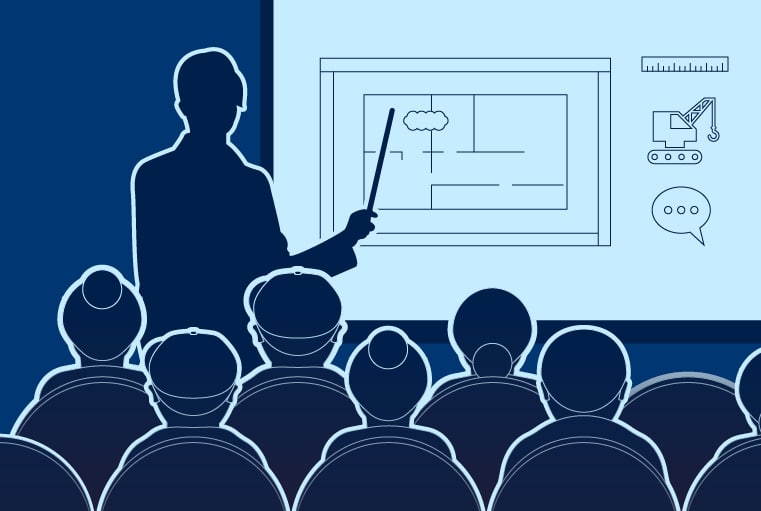Professor Abimbola Windapo teaches in the Construction Economics and Management Department at the University of Cape Town. After working at a multinational construction company upon graduating from college, she went on to get a Ph.D. in construction management from the University of Lagos in Nigeria. Professor Windapo continues to consult on a limited basis—when she’s not preparing the next generation of construction professionals to build their best world. The Bluebeam Blog spoke with Professor Windapo about AI, the challenges facing her students, and where South Africa is relative to its neighbors, the world, and technology adoption in the AEC space.

Built Blog: How has technology changed the architecture, engineering and construction industries?
Professor Windapo: Technology has enabled visualization, trades conflict clash detection/coordination, document sharing, digital collaboration, reduction in information loss (repository), improved construction pricing, reduction in requests for information (RFIs) on projects, off-site construction and precision, thus making construction deliverables more efficient and competitively priced to the stakeholders, and affording the ability to provide quick feedback to review comments.
Built Blog: I wonder if you have any knowledge of how technology has penetrated the architecture, engineering and construction fields in South Africa compared to other countries? Do you feel that South Africa is ahead, or behind, in this respect?
Professor Windapo: When compared to other countries that I have visited and interacted with professionals, such as the USA, UK, Singapore and Australia, I view that technology has yet to penetrate the AEC field in South Africa to the level in the countries mentioned. However, when compared to other countries in Africa, South Africa is a leader in the use of technology, and a number of its top companies are doing well in the international space (for example WBHO). I feel that South Africa is behind the developed countries, but is ahead of emerging economies in terms of the level of diffusion of technology in its AEC sector. The limitation is prominent at low cadre construction levels where the basic education and skills are lacking, and something as simple as buying an iPad or tablet for application of free construction online tools is not affordable.
Built Blog: Can you tell me about a favorite project you worked on prior to your teaching career? And then more recently, what’s the most enjoyable course you’ve taught, and why?
Professor Windapo: This favorite project would be the design and construction of a mosque in Nigeria. The mosque had to be fitted with a golden dome. Because the project was situated in a conspicuous area of the town, it attracted a lot of spectators when it was completed. The clients were so pleased with the finished product, in terms of time, value and quality, that they commissioned another similar mosque project.
Construction Management is the most enjoyable course that I have taught. The course is designed to expose the student to the basic principles of management theory, to equip the student with a basic vocabulary of management practice and processes in the context of the construction sector, provide a basic understanding of the characteristics of the construction sector and their impact on the structure of construction companies. The course is also designed to demonstrate the application of management principles to a single-dwelling construction project. The course introduces the student to how projects are procured and the agents involved in the procurement process. Therefore, I love the lightbulb moments when students realize the depth and breadth of the construction management discipline. Most of the students are not fully aware yet of the construction supply chain and the actors involved when they sign up for the course.
You can access the eBook I developed for the course (Fundamentals of Construction management) here.
Built Blog: How do you use Bluebeam Revu in the classroom?
Professor Windapo: I use Revu in the classroom for teaching students how to edit for review comments and highlight changes to PDF drawings and documents that enable the construction project delivery and production processes to be more efficient. They also use Revu to appreciate measurement and quantities, prepare technical reports and find conflicts between construction trades and plans. In general, it has extensive applications as per coordination between construction trades and conflict resolution.
Built Blog: What has some of the feedback from students been after you’ve taught them Revu?
Professor Windapo: The feedback given by the students after being taught Revu has been positive. It includes the fact that they like the exposure to technology that helps them mark up plans and measure a building component. Note that some students learn how to use Revu themselves because it is available in the computer lab. I have known students to include an ability to use Bluebeam Revu as a skill on their CVs to improve their chances of getting industry high-end jobs. It has also provided my students a great opportunity to deliver assignments in a faster lead time and providing more concise and resourceful critical analysis of projects and papers.
Built Blog: What other technologies do you consider essential for people who plan to work in architecture, engineering and construction?
Professor Windapo: Other technologies that I consider essential for people who plan to work in architecture, engineering and construction, are building information modeling/management (BIM), which offers a digital representation of physical and functional characteristics of a facility, and automation technologies such as 3D printing and smart infrastructure. The impact on the coordination, takeoffs and clarity of rendering of final building elements during the design phase cannot be overemphasized.
Built Blog: How has your view of technology in the architecture, engineering and construction workplace evolved over the years?
Professor Windapo: This is an important question. I have a very positive view of technology and try as much as possible to embrace it as a construction professional through the years. I view that embracing technology improves the competitiveness of professionals and construction businesses. I started as an Engineer in Bouygues (Nig.) Ltd. about 30 years ago. Bouygues is known for the use of cutting edge technology on their projects and in their business, which helps improve their competitiveness in the construction sector. Bouygues is ranked within the top 10 global contractors. Because of this early exposure to technology, I view technology as a necessity that needs to be embraced by professionals and businesses in the construction industry. In other words, the industry today is technology driven, and there is no exception: Anyone who is going to make a profit or interpret any construction-related document from cradle to grave won’t survive without having a technological tool handy. Furthermore, the construction industry is running as a paperless industry in autopilot mode, and the time for carrying a bunch of construction documents either as drawings or specifications will soon be a thing of the past or committed to dust bins.
Built Blog: What do you think is the biggest challenge future professionals in these fields will face? For instance, will it have to do with learning new technologies, dealing with a labor shortage, etc.
Professor Windapo: The most significant challenge future professionals in the AEC field will face is the need to learn new technologies. Professional will also have to cope with disruption to the structure of the industry because interns, entry level or less experienced professionals who have acquired knowledge of these technologies will be paid more than the older, skilled worker who is not technologically savvy. Also, new professions will be created, the old order based on past practices will change. The craft-based construction industry is technically averse, and therefore, I do not foresee a shortage of labor knowledgeable in the use of technology in the distant future.
One major challenge the industry will have to accommodate is the application of robots and advanced artificial intelligence deployment leading to major human resources manpower loss.
Built Blog: How has your view of technology in the AEC workplace evolved over the years?
Albrecht: I don’t really think it has changed too much. I started in the industry in the early ‘00s when 3D modeling was just being adopted but took five minutes to refresh each time you tried to rotate the model. I would say I am most blown away by the continually improving speed at which things can be done—whether that be the processing speed of the graphics on our computers, or the collaborative capabilities of enterprise software.











